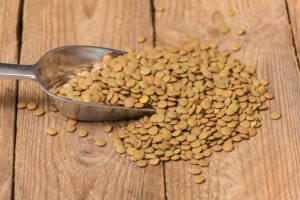Written by Jessica Patella, ND. Combining lentils with rice or potatoes significantly reduced glycemic response in the 24 participating subjects compared to those in the control group.
 According to the America Diabetes Association over 30 million adults have diabetes, almost 10% of the population in the United States 2. Regulating blood sugar levels is important not only for diabetes but also for avoiding diabetes. Historically consuming lower glycemic index foods has been helpful, but recent research shows combining starchy foods with lentils helps regulate blood sugar levels 1.
According to the America Diabetes Association over 30 million adults have diabetes, almost 10% of the population in the United States 2. Regulating blood sugar levels is important not only for diabetes but also for avoiding diabetes. Historically consuming lower glycemic index foods has been helpful, but recent research shows combining starchy foods with lentils helps regulate blood sugar levels 1.
Healthy adults from 18-40 years of age, without diabetes were recruited for the study. A total of 48 participants were randomly and equally divided into two groups (n=24), either a rice group or potato group 1. Treatments included white rice or white potato alone or in combination with lentils (variety of large green, small green and split red lentils). Groups were standardized to provide 50 grams of available carbohydrates 1.
Participants arrived at the study center after a 10-12 hour fast for each visit. They had to consume a prepared food either white rice, white rice with lentils, potatoes or potatoes with lentils depending on their group, within 10 minutes with 250 mL of bottled water.
Results were as follows:
- Both the rice and potato groups showed similar blood glucose and blood insulin patterns, increasing from baseline, peaking at 30 minutes and returning towards baseline by 120 minutes after consumption.
- Compared to rice alone, rice with lentils resulted in significantly lower blood glucose at 15, 30, 45 and 90 minutes following consumption (P<0.05).
- Plasma insulin was no different at any time point when comparing rice or rice with lentils.
- Replacement of 25g of rice with lentils resulted in a reduction in glycemic response compared to rice alone by 13.5% with large green lentils, 21.5% with small green lentils, and 20.5% with split red lentils.
- Compared to potato alone, lentil and potato mixed meals resulted in significantly lower blood glucose and insulin at all time points between 15-60 minutes following consumption (P<0.05).
- Replacement of 25g of potatoes with lentils resulted in a reduction in glycemic response compared to potatoes alone by 33.8% with large green lentils, 33.9% with small green lentils, and 35.6% with split red lentils.
This was the first study to compare blood glucose effects of lentils in combination with high glycemic starchy foods of rice and potatoes 1.
In conclusion, replacing half of the active carbohydrate in a starch-rich food, such as rice or potato, with lentils (large green, small green or split red) significantly reduced the blood glucose response 1. These results can be helpful in recommendations to lower glycemic response by combining lentils with rice or potatoes. Future research should include a larger study group across various population groups to see if results are consistent 1.
Source: Moravek, Dita, Alison M. Duncan, Laura B. VanderSluis, Sarah J. Turkstra, Erica J. Rogers, Jessica M. Wilson, Aileen Hawke, and D. Dan Ramdath. “Carbohydrate Replacement of Rice or Potato with Lentils Reduces the Postprandial Glycemic Response in Healthy Adults in an Acute, Randomized, Crossover Trial.” The Journal of nutrition 148, no. 4 (2018): 535-541.
© 2018 American Society for Nutrition. All rights reserved.
Posted July 17, 2018.
References:
- Moravek D, Duncan AM, VanderSluis LB, et al. Carbohydrate Replacement of Rice or Potato with Lentils Reduces the Postprandial Glycemic Response in Healthy Adults in an Acute, Randomized, Crossover Trial. The Journal of nutrition. 2018;148(4):535-541.
- Diabetes Statistics. American Diabetes Association. http://www.diabetes.org/diabetes-basics/statistics/ Accessed on 7/1/18

